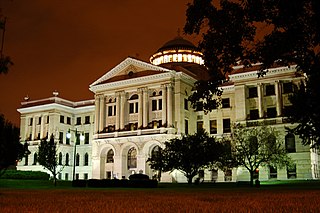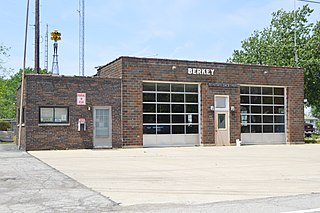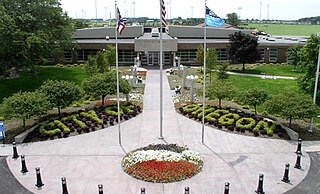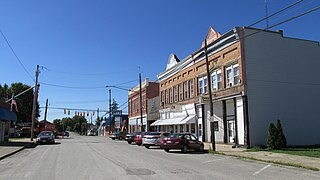
Lucas County is a county located in the northwestern part of the U.S. state of Ohio. It is bordered to the east by Lake Erie, and to the southeast by the Maumee River, which runs to the lake. As of the 2020 census, the population was 431,279. Its county seat and largest city is Toledo, located at the mouth of the Maumee River on the lake. The county was named for Robert Lucas, 12th governor of Ohio, in 1835 during his second term. Its establishment provoked the Toledo War conflict with the Michigan Territory, which claimed some of its area. Lucas County is the central county of the Toledo Metropolitan Statistical Area.

Catawba is a village in Clark County, Ohio, United States. The population was 245 at the 2020 census. It is part of the Springfield, Ohio Metropolitan Statistical Area.

Donnelsville is a village in Clark County, Ohio, United States. The population was 255 at the 2020 census. It is part of the Springfield, Ohio Metropolitan Statistical Area.

South Vienna is a village in Clark County, Ohio, United States. The population was 402 at the 2020 census. It is part of the Springfield, Ohio Metropolitan Statistical Area.

Amsterdam is a village in northwestern Jefferson County, Ohio, United States. The population was 436 at the 2020 census. The community was founded by Dutch immigrant David Johnson and named after the city of Amsterdam, Netherlands. It is part of the Weirton–Steubenville metropolitan area.

Berkey is a village in Lucas County, Ohio, United States. The population was 275 at the 2020 census.

Maumee is a city in Lucas County, Ohio, United States. Located along the Maumee River, it is a suburb about 10 miles (16 km) southwest of Toledo. The population was 13,896 at the 2020 census. Maumee was declared an All-America City by the National Civic League in June 2006.

Oregon is a city in Lucas County, Ohio, United States. Located on Lake Erie, it is a suburb of Toledo lying east of the city and is home to Maumee Bay State Park. The population was 19,950 at the 2020 census.

Ottawa Hills is a village in Lucas County, Ohio, United States. The population was 4,790 at the 2020 census. The village was developed on both sides of the Ottawa River (Ohio) and serves as a bedroom community and suburb of Toledo.

Waterville is a city in Lucas County, Ohio, United States, along the Maumee River. A suburb of Toledo, the population was 6,003 at the 2020 census.

Whitehouse is a village within the Toledo Metropolitan Area in Lucas County, Ohio, United States. The population was 4,990 at the 2020 census.

New Middletown is a village in southeastern Mahoning County, Ohio, United States. The population was 1,507 at the 2020 census. It is part of the Youngstown–Warren metropolitan area.

Ludlow Falls is a village in Miami County, Ohio, United States. The population was 175 at the 2020 census. It is part of the Dayton Metropolitan Statistical Area. Ludlow Falls is named after surveyor Israel Ludlow.

Cloverdale is a village in Perry Township, Putnam County, Ohio, United States. The population was 170 at the 2020 census.

Dupont is a village in Putnam County, Ohio, United States. The population was 212 at the 2020 census.

Lakemore is a village in Summit County, Ohio, United States. The population was 2,926 at the 2020 census. It is part of the Akron metropolitan area.

North Baltimore is a village in Wood County, Ohio, United States and is part of the Toledo, OH Metropolitan Statistical Area. The population was 3,369 at the 2020 census. The village is a member of the Toledo Metropolitan Area Council of Governments.

Clifton is a village in Clark and Greene counties in the U.S. state of Ohio and is home to the Clifton Mill, one of the largest water-powered grist mills still in existence. The population was 131 at the 2020 census.

New Holland is a village in Fayette and Pickaway counties in Ohio, United States. The population was 804 at the 2020 census.

Tremont City is a village in Clark County, Ohio, United States. The population was 352 at the 2020 census. The village is part of the Springfield, Ohio Metropolitan Statistical Area.






















